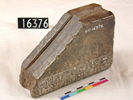| Homepage | Timeline | Maps | A-Z index | Learning |
Measuring time: hours
In Ancient Egypt and classical Greek and Roman times (so including the Roman Period in Egypt) there were two main devices for measuring time.
Waterclocks
A bowl with a very small hole was filled with water. The water disappeared slowly through the hole. The time could be measured by the level of water left in the bowl. Marks on the inside of the bowl provide the hours. Another type of water clock had a float in the water. The float is connected with a 'hand' indicating the time on a board. In Egypt the earliest preserved waterclocks date to the New Kingdom (about 1550-1069 BC): the finest example dates to the reign of Amenhotep III, and was found in the Karnak temple cachette (Egyptian Museum, Cairo 37525). Most survive as fragments and date to the fourth century BC.
|
fragment of a waterclock
|
|
 |
 |
Sundials (also shadowclocks)
There are two main types: 1. Sundials measuring the length of the shadow. 2. Sundials measuring the direction of the shadow.
|
shadow clock
|
sundial
|
further reading:
|

